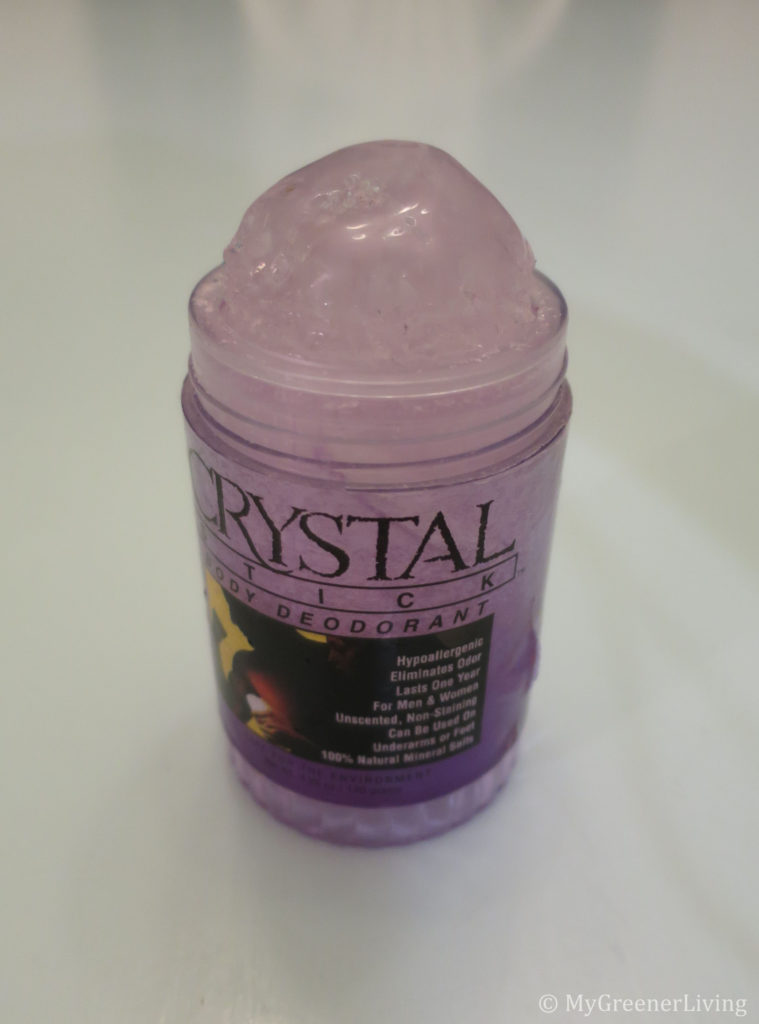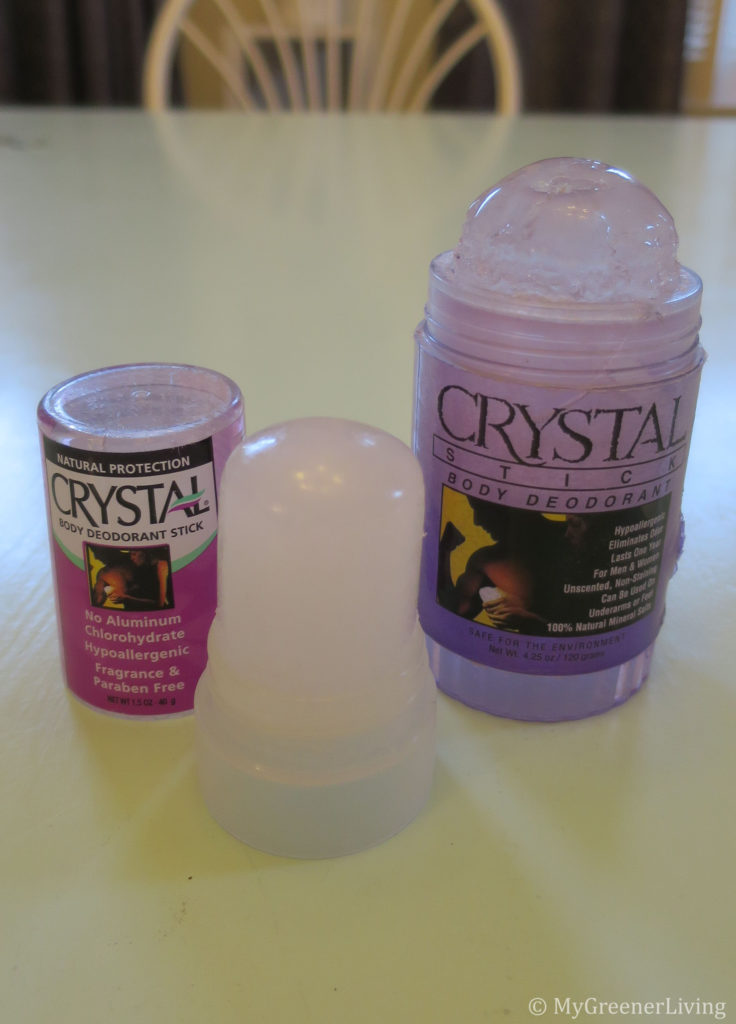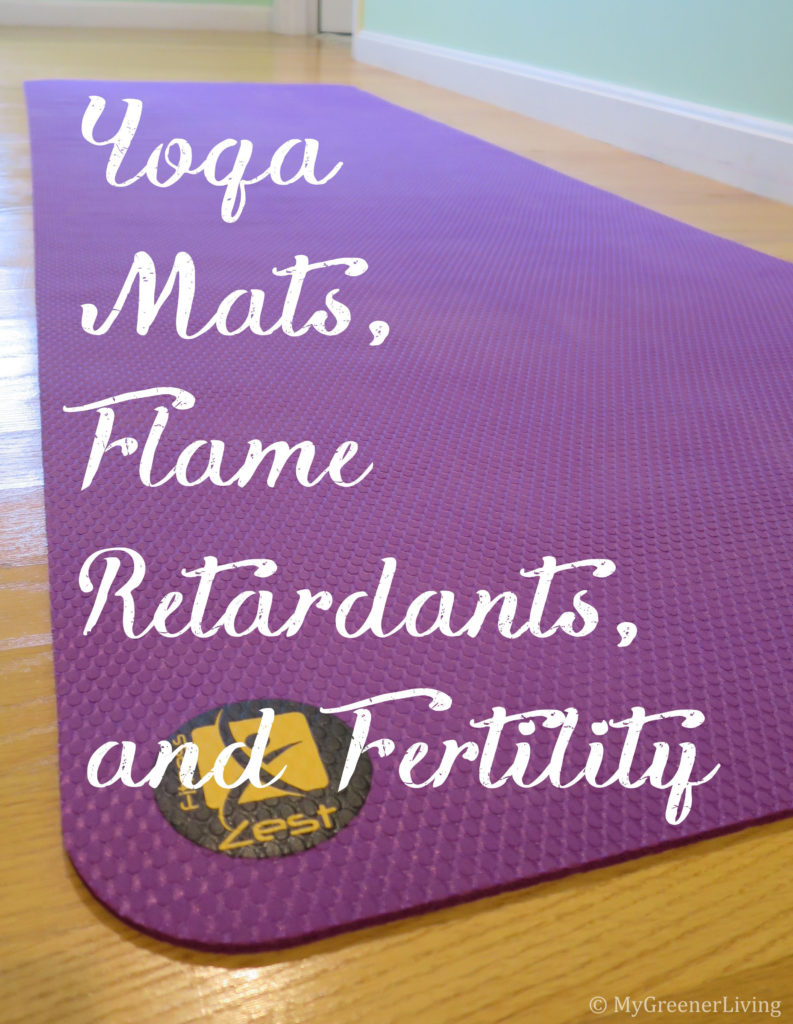I have been very hesitant to write this post, because there is so much controversy over what makes a “safe” deodorant. But I want to share with you the products I have researched and what I choose to use as a natural deodorant.
Disclaimer: This post contains affiliate links. See my Disclosure Policy for more information.

Note: I have found a new favorite deodorant, a homemade version. I now use this homemade natural deodorant. I found this recipe works best for me, but for a commercially available option, the deodorant in this post is the best option for me.
Crystal Stick Body Deodorant – a Natural Deodorant
My choice natural deodorant is Crystal Stick Body Deodorant. It has a single ingredient: Potassium Alum (Natural Mineral Salts). Unlike conventional deodorant, to use, you need to wet the end of the deodorant stick before rubbing on skin. The water dissolves the outer layer of the crystal stick, so when rubbed on skin and the application water evaporates, it leaves a thin layer of the mineral. I’ve found that it dries quickly. Unlike the liquid roll-on deodorants, as soon as I apply I go about my routine. I don’t worry about keeping my arms in the air waiting for it to dry, and I have not noticed any ill effects.

Pros
It got an Environmental Working Group, or EWG, rating of 1, on a scale of 1-5, with 1 being best/safest.
Crystal Stick Body Deodorant is effective at preventing stinky sweat.
It lasts a long time. I’ve been using mine for 2.5 years so far, and still have at least 1/3 of my 4.5 oz stick remaining. I estimate it’ll last me 3-4 years. I use it once or twice a day.
There is no color, no clumping, no scents. It does not mark or stain clothing.
I have never had any kind of skin reaction.
It is deodorant only, not antiperspirant.

Cons
Crystal Stick Body Deodorant comes in plastic packaging.
It is deodorant only, not antiperspirant.
You’re probably thinking that I have an error there. I listed “it is deodorant only, not antiperspirant” as both a pro and a con. Not an error, this is intentional. I consider it a pro because sweating is a natural, healthy bodily function. Sweating cools the body. Using antiperspirants blocks sweat from being released. I believe that blocking sweat is not good for the body (just my personal opinion). But, it is a con because sweating and sweat stains are annoying.
Other options I’ve used
Prior to me becoming more conscious of chemicals in products and going into my body, I used several different deodorants and antiperspirants. Due to my known skin sensitivities, I knew I needed to avoid fragrances. But little did I know even these “sensitive” products were laden with irritating, unhealthy chemicals.
Commercially available products I have tried and no longer use
- Dove Antiperspirant & Deodorant, for Sensitive Skin: EWG rating 4
- Secret Clinical Strength Women’s Antiperspirant & Deodorant, Sensitive/Hypoallergenic Unscented: EWG rating 4
- Ban Antiperspirant & Deodorant, Unscented: EWG rating 1
I no longer use Dove or Secret due to the ingredients which I believe are unhealthy and irritating. The Ban deodorant & Antiperspirant didn’t work well for me as an antiperspirant, and for simply a deodorant, I prefer Crystal Stick for its short ingredient list and low price.
Homemade natural deodorants I have tried and no longer use
As you probably know by now, I am a big fan of DIY and making my own products. So naturally, I did try making my own deodorant. I tried this detoxifying deodorant and coconut oil with arrowroot powder dabbed on. But, they took multiple ingredients and effort to make and use, the oils felt kind of weird on my skin. I found Crystal Stick to be cheaper, easier, more comfortable, more travel-friendly, and equally or more effective than the homemade versions.
Other deodorant options
If you’re looking for other ideas and options for natural or unscented deodorants and antiperspirants, this post may help. It includes some that I have already mentioned, but others that I have not tried, and includes men’s as well as women’s deodorants and antiperspirants. Note that this contains natural deodorants and those with synthetic chemicals.
Cost
As of November 2017, Crystal Stick Body Deodorant is about $11 for 2-4.25oz sticks on Amazon, or about $7 each at Stop & Shop and CVS. Assuming, conservatively, that one stick lasts 3 years, using this deodorant costs only $11/2 sticks/3 years=$1.83 per year.
Conventional deodorants typically cost $3-$6 per tube, and used to last me 6 months or less. $1.83 for a year’s use of Crystal Stick versus $6+ for a year’s use of conventional deodorant. Here’s another case where the healthier option is the more frugal option!

The manufacturer also sells a 1.5 oz travel size Crystal Stick Body Deodorant, which I have only found on Amazon. It’s $6.30 for 2-1.5 oz tubes as of November 2017.
Have you tried another more natural deodorant? Please share the good or the bad in the comments below!



